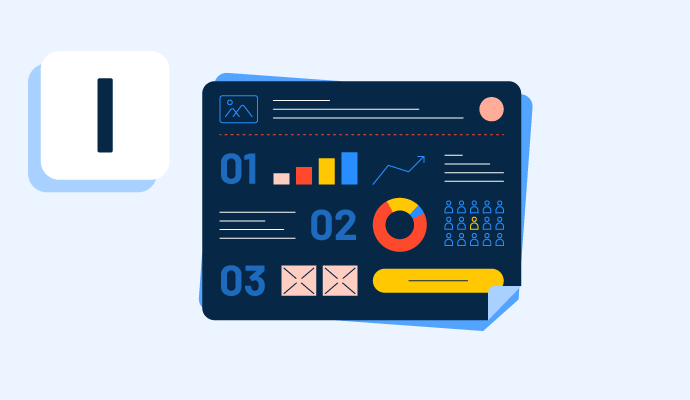What is an infographic?
An infographic is exactly what it sounds like: a digital graphic that uses visuals to present information. The substance and purpose of an infographic varies from industry to industry, but in general, they’re designed to be scannable, easy-to-read, and visually appealing. Infographics can include maps, word clouds, timelines, or instructions.
Many types of software provide some sort of design creation ability, but desktop publishing software is purpose-built to help marketing and creative teams design, edit, and publish content like infographics in both print and digital form.
Types of infographics
Because infographics serve a wide variety of purposes, they come in many different forms. Each one uses different design elements and information sources in their designs.
- Statistical or data visualization
- Informational or summary
- List or listicle
- Process
- Timeline
- Comparison
- Geographic
- Anatomy of a person, animal, or thing
- Visual resumes
- Flowcharts
- Decision trees
Steps to make an infographic
Infographics condense information into a concise, designed format. To accomplish this, teams use a few required steps to bring an infographic from ideation to design to publication.
In general, these steps are as follows.
- Determining the right content to include and how it should be organized. If there’s a story to tell with data, designers figure out what the story is and which kind of infographic matches that story.
- Gathering all of the relevant information.
- Creating a wireframe for the infographic to prepare design teams. Sometimes, this wireframe is determined by a pre-built template, and other times the wireframe is brand new. This wireframe helps writers and designers know what they have to work with.
- Writing the content that fills the infographic. In general, infographics need to include an introduction to the topic, a body copy to illustrate the story, and a conclusion to summarize the information and compel the reader to take a certain action. This is the 'info' part of an infographic.
- Designing the infographic. After the copy is finalized, it’s passed to the design team. This is the 'graphic' part of an infographic.
- Figuring out how and where the infographic should be used. Infographics can be included in blog posts, posted on social media, or placed on the company’s website. Sometimes, infographics are printed for display or saved in a PDF format for others to share digitally.
Some infographics don’t require every step listed above, so it’s possible to skip them if they don’t serve the right purpose. For example, if a marketing team is looking to create an infographic that details a list of best practices for their product, gathering data won’t necessarily be a required step.
Benefits of infographics
Infographics are so popular in part because they are interesting and engaging to readers. They condense a significant amount of information into a neat package.
Other benefits to consider are below.
- They’re easily scannable. Many people find images and data visualizations easier to read than paragraphs of text, especially when the information is the same.
- They’re visually appealing and more fun to engage with.
- Processes, timelines, and maps are easier to illustrate through infographics than text alone.
- Depending on their design, infographics can guide the viewer through a specific journey.
- Shareability is higher than other mediums, especially if shared through social media, resulting in more engagement and website visitors.
- Well-designed infographics are great for brand recognition and identity.
Drawbacks of infographics
Though the benefits of infographics cannot be overstated, a few drawbacks to using infographics may arise, just like with any visual medium.
- In a digital format, if an image doesn’t load, all of the information is lost to the reader. Similarly, anyone using a digital assistant or screen reader won’t be able to understand the content without alt text (alternative text that is to be displayed in place of an element that cannot be rendered).
- The visual nature of infographics doesn’t always allow marketers to include all the information necessary for the topic. This can cause the omission of vital information.
- Because infographics typically don’t include a lot of copy, it can be hard to condense difficult topics into short, punchy text, potentially lengthening the writing phase of the process.
Best practices for creating infographics
With these benefits and drawbacks in mind, businesses ought to implement the following elements of best practices.
- Alt text for the infographic or a complete text version below it, if possible, businesses guarantee most readers can take in the information, no matter how they consume it.
- Pre-built templates. These are particularly useful if no full-time designers are on the team or the timeline is rushed. Many creation tools that provide pre-built templates are available to use.
- Concise copy. Because infographics rely on visuals, any text associated with them should be clear and to the point.
- Animated and interactive components. Interactive content has become increasingly popular, and infographics are uniquely qualified to take advantage. Infographics don’t always have to be static, so making use of animation is an option.
Learn more about the history of infographics and get some inspiration for your own. Spoiler alert: It all started with cave drawings and hieroglyphics!

Whitney Rudeseal Peet
Whitney Rudeseal Peet is a former freelance writer for G2 and a story- and customer-centered writer, marketer, and strategist. She fully leans into the gig-based world, also working as a voice over artist and book editor. Before going freelance full-time, Whitney worked in content and email marketing for Calendly, Salesforce, and Litmus, among others. When she's not at her desk, you can find her reading a good book, listening to Elton John and Linkin Park, enjoying some craft beer, or planning her next trip to London.





















